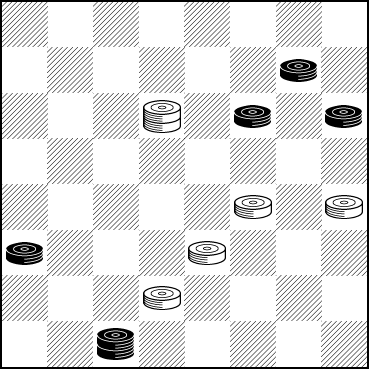The Checker Maven
Jump to navigationA Twin

Image by 'Suzu2' under Creative Commons license
In today's Checker School column, we continue with what Andrew J. Banks, in his eclectic book Checker Board Strategy, calls a "beginner's problem" although he does make something of a retraction of that statement, as we shall see.
Mr. Banks tells us that a problem whose terms contains the phrase "Either to Play" is known as a twin, for fairly obvious reasons. He gives the following example.

WHITE
Either to Play, White to Win
W:WK10,19,20,23,26:B8,11,12,21,K30
Although we've shown this from the White side, the terms in fact do hold. We don't see a lot of problems of this type and it's quite interesting. Is it, in fact, easy enough for beginners? Mr. Banks recants by saying, "Tough problem for a BEGINNER!!!"
Tough or not will depend on your skill level but we think it will entertain most everyone. Find both solutions, if you can, and then click on Read More to see the solutions.![]()
Solutions
Mr. Banks first shows the solution with Black to move.
21-25---A10-14---B 25-29 14-17 29-25 17-21 25-29 26-22 29-25 23-18 25-29 18-15 11x25 19-15 White Wins.
A---11-15 19-16 White Wins.
B---19-16 12-19 23-7 30-23 Drawn.
Mr. Banks calls this a "block" or "lock" trap. That much is clear; he also says this is also called a "Slocum stroke." Well, possibly.
With White to move, play is as follows.
10-14---A 21-25 14-17 25-29 17-21 29-25 19-16 White Wins.
A---19-16 12-19 23-7 30-23 to a draw.
Here Mr. Banks notes this is an illustration of how changing the move changes the theme.
We hope you found today's "Twin" as interesting as we did.

You can email the Webmaster with comments on this article.
